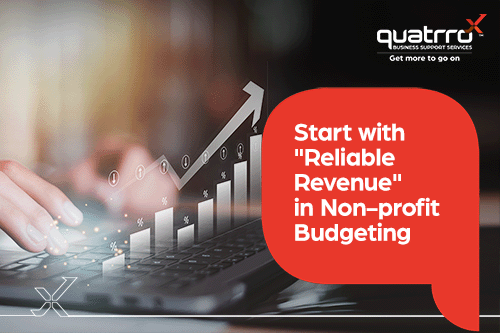Blog Details
Start with “Reliable Revenue” in Non- profit Budgeting
April 17, 2025

One of the most challenging tasks for non-profit executives is creating a budget that balances mission execution against the often-harsh reality of available funding resources. While building a plan to create maximum impact is critical, ensuring financial sustainability is equally important.
Having served as a non-profit CFO, both directly and as an outsourced partner through Quatrro over many years, I can attest to these challenges. Visionary leaders typically start with the expenses needed to execute their mission, then work backwards to identify high-probability funding, which often leads to a budget gap that needs to be filled with less confident revenue sources. The temptation is to assume this gap is achievable and therefore acceptable for budgeting purposes.
Over the years, I’ve advised my non-profit clients to build budgets based on “reliable revenue”. For some reason, the word “reliable” resonates with executive teams, committees, and board members more effectively than “high probability” or “certain” funding streams.
What Constitutes Reliable Revenue?
Major Grants, Gifts, and Contributions
- Funds committed for the following year either unconditionally or in forms where there’s every expectation that conditions will be met should be included.
- High-probability pending asks, especially those with a track record of past giving,also have a solid basis for inclusion in the budget.
Annual Fund, Individual Giving, and Various Earned Revenue Streams
- Use a reasonable three to five-year low watermark figure as a starting point for considering as reliable revenue.
Once this exercise is complete, if there’s a difference between “reliable revenue” and projected expenses, I compare the remaining gap to the available cash on hand at the beginning of the budget period. This determines if reserves would be sufficient, if needed, to sustain the organization through the year. If the result comes up short, the organization must either adjust expenses or accept the existential risk of proceeding with the gap.
After completing the reliable revenue budget exercise, an organization will have a solid starting point for budgeting expenses. Of course, there’s often a back-and-forth process: “What if we spent more on this program or invested more in that project? What additional revenue might this generate through the funding community or earned revenue streams?”
This is a healthy exercise and one of the primary reasons the budget and planning process should begin early enough in the previous year to allow for thoughtful deliberation, challenging of assumptions, and aspirational discussions around planning.
The approach I’ve outlined aims to avoid what one museum CEO humorously expressed to me recently: “Non-profit organizations are faith-based organizations’. We have to take a leap of faith every year during our budget process.”
My experience suggests that setting parameters around budgeting for reliable revenues may not result in the most exciting budget process, but it helps ensure financial sustainability, especially during times of uncertainty. Of course, there are no absolute guarantees around reliable funding, and leadership and boards must determine the amount of risk justified for the continuity of their mission and programs.







